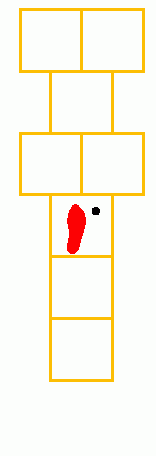Hopscotch
Hopscotch is over 300 years old and can be played alone or with many. A small marker is thrown into squares outlined on the court. Players hop or jump from number to number until they are able to pick up the marker.

Modern schoolyard court; designs vary.
Definition:
According to the Oxford English Dictionary hopscotch is a formation from the words “hop” and “scotch,” the latter in the sense of “an incised line or scratch.” The journal of the British Archaeological Association, Volume 26 (dated March 9, 1870) states, “The sport of Hop-Scotch or Scotch-Hoppers is called in Yorkshire ‘Hop-Score,’ and in Suffolk ‘Scotch Hobbies or Hobby,’ from the boy who gets on the player’s back whilst hopping or ‘hicking,’ as it is there termed; and in North Britain it is known as ‘Peevers, Peeverels, and Pabats.'”
Origin:
An form of hopscotch may have been played by Roman children. The first recorded references to the game in English-speaking world date back to the late 17th century, usually under the name “scotch-hop” or “scotch-hopper(s)”. A manuscript Book of Games compiled between 1635 and 1672 by Francis Willughby refers to ‘Scotch Hopper‥. They play with a piece of tile or a little flat piece of lead, upon a boarded floore, or anie area divided into oblong figures like boards’. In Poor Robin’s Almanack for 1677, the game is referred to as “Scotch-hoppers”. The entry states, “The time when schoolboys should play at Scotch-hoppers.” The 1707 edition of Poor Robin’s Almanack includes the following phrase… “Lawyers and Physicians have little to do this month, so they may (if they will) play at Scotch-hoppers.” In 1828 Webster’s An American Dictionary of the English language also referred to the game as ‘Scotch-hopper’…’a play in which boys hop over scotches and lines in the ground.’
Since the game was known and popular in the seventeenth century, it is logical to suppose it may have existed at least a few decades (or perhaps even many centuries) before its earliest literary reference; but no conclusive evidence has yet been presented to support this theory.
Playing the game:
A hopscotch court is first laid out on the ground. The course may be lined out in dirt, or drawn with chalk on pavement. The course usually has single squares and sometimes two squares side by side. Often the course ends with a “safe” or “home” base in which the player may stop at before completing the trip back. The home base can be a rectangle, a square, or a semicircle. The squares are then numbered in numerical order.
The first player tosses the marker (a stone or coin etc.) into the first square. The marker must land within the square and and not touch a line. Players hop through the course, skipping the squares with the markers. Single squares are hopped on one foot. Either foot may be used at the first square. Side by side squares are straddled, with the left foot landing in the left square, and the right foot landing in the right square. The square marked “Safe”, “Home”, or “Rest” can be landed on one or both feet.
At “Safe”, “Home”, or “Rest” the player must then turn around and return through the course until they reach the square with their marker. They then must pick up their marker and finish the course without touching a line or stepping into a square with a marker belonging to someone else. If successful, one continues the turn by tossing the marker into the next square, and starts again. The turn ends if, while hopping in either direction, the player steps on a line, misses a square, or loses balance. Players start a new turn from where they last left off. The first player to do every numbered square on the court wins the game.
References and additional reading:
Beard, D.C. (1907). The Outdoor Handy Book: For the Playground, Field, and Forest. New York: Charles Scribner’s Sons. pp. 356–357.
Cram, David, Forgeng, Jeffrey L. and Johnston, Dorothy, The Book of Games of Francis Willughby (1635-1672). A Seventeenth-century Treatise on Sports, Games and Pastimes (Aldershot, 2003)
Lankford, Mary T.; Karen Dugan (1992). Hopscotch Around the World. New York: William Morrow. ISBN 0-688-14745-3.
Shadwell, Thomas (1668). The Sullen Lovers. :’ Play at Catt, Stoolball, Scotch-hopp and Trap-ball.’ Cited in Oxford English Dictionary, Third edition, June 2011; online version March 2012
Wikimedia Commons has media related to Hopscotch:
